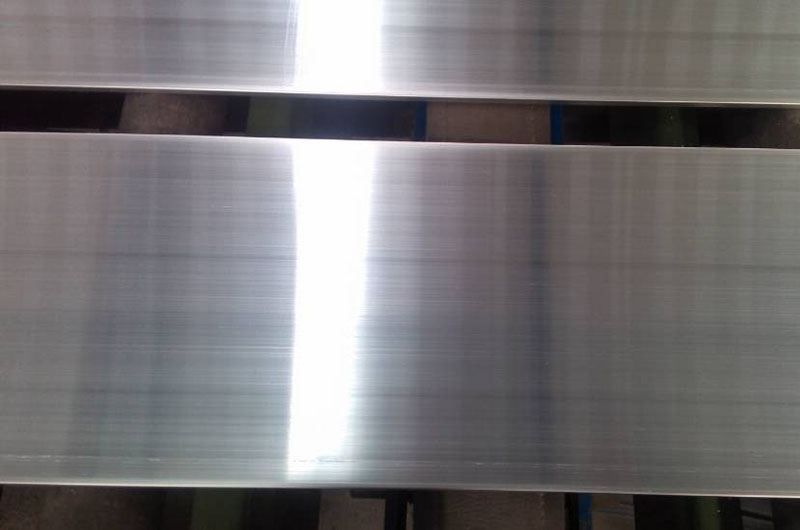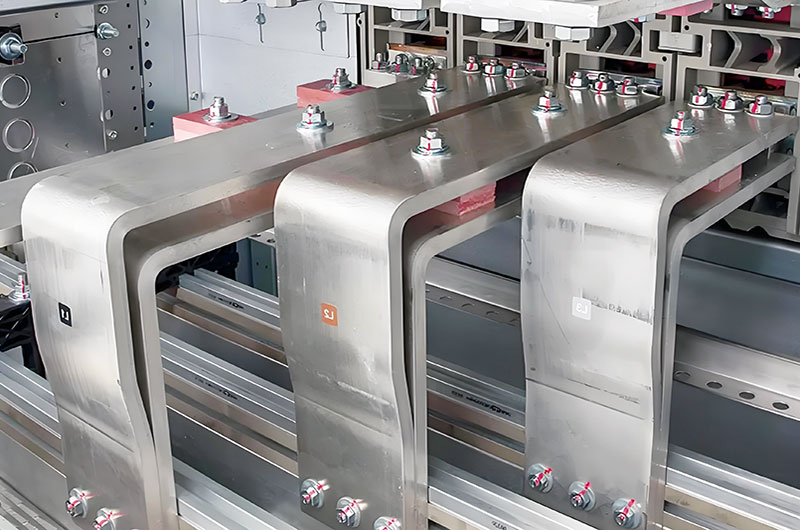The 6082 aluminum busbar is a conductor made from 6082 aluminum alloy, which belongs to the 6000 series. It is known for its medium strength, excellent corrosion resistance, and good weldability. Due to its lightweight compared to copper, the 6082 busbar is particularly popular in applications where reducing overall weight without compromising performance is essential.

Specification of HC Aluminum 6082 electrical aluminum busbar
| EC 6080 Aluminum Busbar Specifications | |
| Temper | T3, T4, T5, T6 |
| Shape | Rectangular, round, or tubular profiles; rectangular is the most common for effective current distribution. |
| Surface Quality Requirements | Smooth surface, free of burrs, spots, and other defects; clean surface, free of dust, oil, and other impurities; uniform and dense oxide layer with good corrosion resistance. |
| Surface Treatment | Anodizing, electroplating, coating, etc. Common aluminum plating layers include silver, tin, and nickel. |
| Insulation Treatment | Insulating coatings: powder coating, epoxy resin coating, or insulating varnish coating. Insulating sleeves: PVC, heat shrink tubing, or silicone rubber. |
| Processing | Stamping, bending, drilling, tapping, polishing, etc. |
| Testing | Conductivity testing, temperature rise testing, bending testing, salt spray test (e.g., ASTM B117), etc. |
| Standards | ASTM B317: Standard specification for aluminum bus conductors. |
| IEC 60439: Low-voltage switchgear and controlgear assemblies. | |
6082 Aluminum Busbar Material Composition and Properties
6082 Aluminum Busbar Chemical Composition
6082 aluminum is primarily composed of aluminum, with carefully controlled amounts of additions:
- Silicon: 0.7–1.3%
- Magnesium: 0.6–1.2%
- Manganese: 0.4–1.0%
- Trace elements: trace iron (up to 0.5%), copper (up to 0.1%), chromium, and zinc
| Alloy | Si | Fe | Cu | Mn | Mg | Cr | Ni | Zn | Ti | Ga | V | Others | Aluminium min. | |
| Each | Total | |||||||||||||
| 6082 | 0.7-1.3 | 0.5 | 0.1 | 0.4-1.0 | 0.6-1.2 | 0.25 | - | 0.2 | 0.1 | - | - | 0.05 | 0.15 | Remainder |
6082 Aluminum Busbar Mechanical Properties (Typical Values for T6 Condition)
- Yield Strength: Approximately 250–260 MPa
- Tensile Strength: Between 290–310 MPa
- Hardness: Approximately 95 HB
- Density: ~2700 kg/m³
- Elongation: 6–10%
6082 Aluminum Busbar Thermal and Electrical Properties
- Melting Range: 585–650 °C
- Thermal Conductivity: Typically 150–170 W/m·K, supports effective heat dissipation
- Electrical Conductivity: Typically in the range of 24–32 MS/m, making it a competitive alternative to heavier conductors.
The combination of these properties makes the 6082 aluminum busbar widely used in industrial power distribution, renewable energy facilities, and even in aerospace and automotive sectors.
Advantages of 6082 Aluminum Busbar
- Lightweight: The weight of 6082 aluminum is about one-third that of copper, reducing the overall system mass.
- Corrosion Resistance: The natural oxide layer of the alloy enhances its durability, even in harsh environments.
- Good Mechanical Strength: Despite its lightweight, it has strong mechanical properties, which are crucial for structural applications.
- Excellent Workability: Easy to machine, form, and weld, enabling a wide range of designs and efficient assembly processes.
6082 Aluminum Busbar Applications
- Power Distribution: Used in switchgear, transformers, and low-voltage distribution panels, where high current capacity and reduced weight are required.
- Renewable Energy Systems: Commonly used in solar power installations and energy storage systems, where efficient heat dissipation is crucial.
- Industrial and Aerospace: Used in fields that require high strength-to-weight ratios, such as aerospace components and automotive structures.

6082 Aluminum Busbar vs Other Materials
Comparison of 6082 with 6061 Aluminum Alloy
| Property | 6082 Aluminum Alloy | 6061 Aluminum Alloy |
| Main Components | Si 0.7-1.3%, Mg 0.6-1.2% | Si 0.4-0.8%, Mg 0.8-1.2% |
| Tensile Strength (T6 Condition) | ≥310 MPa | ≥310 MPa |
| Yield Strength (T6 Condition) | ≥260 MPa | ≥276 MPa |
| Elongation | Approximately 10% | Approximately 12% |
| Weldability | Average (requires special welding materials) | Excellent (commonly uses 5356 welding wire) |
| Corrosion Resistance | Excellent (especially resistant to seawater corrosion) | Good |
| Workability | Good machinability | Better formability |
| Typical Applications | Ship structures, high-load supports | Vehicle frames, general mechanical components |
- 6082: Suitable for high-strength, corrosion-resistant applications (e.g., marine engineering).
- 6061: Better suited for welding and complex forming needs (e.g., vehicle frames).
Difference in Electrical Conductivity between Copper Busbars and Aluminum Busbars
| Parameter | Copper Busbar | Aluminum Busbar (using 6082 as an example) |
| Conductivity | 100% IACS (International Annealed Copper Standard) | 35-40% IACS (approximately 58% of copper conductivity) |
| Current Carrying Capacity (same cross-section) | High (1.6 times that of aluminum) | Low (needs larger cross-section to compensate) |
| Temperature Rise | Low (low resistance, less heat generation) | High (requires heat dissipation design) |
| Cost-effectiveness | High cost, but space-saving | Low cost, but requires a larger cross-section |
| Oxidation Effect | Oxide layer has high resistance (requires tin plating) | Oxide layer remains conductive (natural passivation film) |
- Copper Busbar: high current density applications (such as data center distribution cabinets).
- Aluminum Busbar: medium to low current, lightweight requirement scenarios (such as solar power plant busbars).
What are the Specific Advantages of 6082 T6?
T6 heat treatment process: solution treatment + artificial aging, significantly enhancing mechanical properties.
| Core Advantage | Description |
| Tensile Strength | ≥310 MPa, yield strength ≥260 MPa, more than 3 times higher than ordinary aluminum busbars (such as 1050). |
| Corrosion Resistance | Magnesium-silicon alloy composition forms a stable oxide film, especially suitable for marine, chemical, and other corrosive environments. |
| Machinability | Excellent machinability (cutting speed can be increased by 20% compared to 6061). |
| Lightweight and Structural Efficiency | Specific strength (strength/density) is close to steel, suitable for replacing steel structural components. |
| Fatigue Strength | T6 state fatigue limit increased by 30%, suitable for vibration load scenarios (such as rail transit). |
| Balance of Conductivity and Heat Dissipation | Conductivity 35% IACS, better heat dissipation performance than copper (aluminum thermal conductivity 237 W/m·K vs copper 401 W/m·K, but its lightweight compensates). |
Typical application scenarios:
- Marine power systems (salt mist corrosion resistance).
- Wind tower internal conductive structures (high strength + lightweight).
- Industrial automation equipment supports (balancing conductivity and load-bearing).
6082 aluminum busbars provide the best combination of light weight, mechanical strength, and corrosion resistance, making them ideal for various electrical and structural applications. Their flat bar structure and excellent thermal conductivity ensure efficient heat dissipation, while their robust alloy composition offers reliability in harsh environments.
6082 Aluminum Busbar Manufacturing and Processing
Production Process:
- Extrusion: 6082 aluminum is usually extruded into flat bars, providing excellent heat dissipation surface area, a key factor for high-current applications.
- Heat Treatment: The alloy is typically heat-treated (e.g., T6 temper) to enhance its mechanical properties.
- Processing and Finishing: Post-extrusion processing can refine busbar dimensions, and surface treatments (such as anodizing or plating) can be applied to further enhance corrosion resistance and electrical performance.
Geometric Shapes and Design:
Busbars are typically produced with a flat rectangular cross-section to maximize exposed surface area for effective cooling. Their modular design makes them easy to install, either by bolt connection or welding, facilitating flexible configuration in distribution systems.
Aluminum Busbar Selection and Purchasing Recommendations
How to Select the Right Specifications for Aluminum Busbars?
1. Determine the current load (core parameter)
Current Carrying Capacity Calculation:
Based on the system's maximum operating current (considering short-term overload or fault currents), calculate the busbar cross-sectional area according to IEC 60439 or GB 7251 standards.
- Empirical formula: Cross-sectional area (mm²) ≈ Current (A) ÷ Current density (aluminum typically taken as 1.0~1.5 A/mm², adjusted according to heat dissipation conditions).
- Example: If the load current is 1000A, the cross-sectional area should be 1000 ÷ 1.2 ≈ 833 mm² (you can choose standard specifications like 80×10 mm or 60×12 mm).
Short-term current tolerance:
The busbar's thermal stability and mechanical strength under short-circuit conditions need to be verified (e.g., whether to increase thickness or use a channel structure).
2. Dimensions and Cross-sectional Shapes
Common cross-sectional shapes:
- Rectangular (flat type): Suitable for standard distribution cabinets, easy to install.
- Channel (C-type or U-type): Better heat dissipation, suitable for large currents or high-density installations.
- Custom shapes: Requires customization, used for special heat dissipation or space-limited scenarios.
Size matching:
- Thickness and width: Select based on current-carrying capacity and mechanical strength (e.g., 30×5 mm, 50×6 mm, 100×10 mm, etc.).
- Length: Choose based on installation space to avoid excessive length causing voltage drop or mechanical vibration.
3. Temperature Rise and Heat Dissipation Conditions
Allowed temperature rise: Usually no more than 70°C (with an ambient temperature of 40°C, total temperature ≤110°C).
Heat dissipation design:
- Natural cooling: Ensure the busbar spacing ≥ 1.5 times the busbar thickness.
- Forced cooling: Add heat sinks or air duct design.
4. Mechanical Strength and Installation Method
- Bending strength: The thicker the busbar, the stronger the bending resistance (e.g., for large-span installations, thickness ≥ 8mm).
- Fixing method: Bolt fixing or insulated clamp fixing, avoid loosening due to vibration.
5. Insulation and Protection
Whether insulation is required:
- Bare busbar: Suitable for dry, enclosed environments without short circuits.
- Insulation treatment: Coating with epoxy resin or heat shrink tubing, suitable for humid or short-circuit-prone scenarios.
- Corrosion resistance: In coastal or chemical environments, choose tin-plated or anodized treatment.
What parameters should be considered when purchasing aluminum busbars?
| Item | Description |
| Material and Conductivity | Aluminum purity: Recommended 1060 or 6063 aluminum alloy (conductivity ≥55% IACS). |
| Surface treatment: Tin-plated (anti-oxidation) or sandblasted (enhanced heat dissipation). | |
| Certification and Standards | Compliant with GB/T 5585.1 (aluminum busbar standard) or IEC 61439. |
| The supplier should provide material reports (e.g., SGS testing) and RoHS environmental certification. | |
| Dimension Tolerance | Thickness tolerance: ±0.05 mm, width tolerance: ±1%. |
| Edges should be chamfered to avoid burrs causing discharge. | |
| Supplier Services | Does the supplier support customization (custom cross-sections, special coatings)? |
| Provide current-carrying capacity calculations or thermal simulation reports. | |
| Price and Cost | Compare tax-inclusive unit prices from multiple suppliers (e.g., yuan/meter). |
| Consider long-term maintenance costs (e.g., tin-plating layer lifespan >10 years). |
Why choose HC Aluminum for aluminum busbars?
HC 6082 EC-grade aluminum busbars comply with IEC 60105, ISO 209-1, DIN EN 755-2, DIN EN 755-5 standards, offering excellent conductivity, high strength, good corrosion resistance, and lightweight design.
HC Aluminum Selection Recommendations for Aluminum Busbars
- Prefer copper busbars: for ultra-high current density and space-limited scenarios.
- Prefer 6082-T6 aluminum busbars: for medium to high load scenarios requiring a balance of strength, corrosion resistance, and lightweight design.
- Choose 6061 aluminum busbars: for complex welding and forming needs (e.g., electric vehicle battery trays).
- Avoid aluminum busbars: for microcurrent precision circuits (oxidation layers may cause poor contact).
Common Misconceptions in Aluminum Busbar Selection
- Misconception 1: Selecting based solely on cross-sectional area, ignoring heat dissipation conditions. It is necessary to verify the actual current-carrying capacity through temperature rise tests.
- Misconception 2: Choosing non-standard products to save costs. Non-standard busbars may lead to local overheating or installation incompatibility.
Typical Application Scenario Recommendations
| Scenario | Recommended Specification | Key Parameters |
| Low Voltage Distribution Cabinet (400V) | 60×6 mm Bare Busbar | Current-carrying capacity of approximately 800A, natural cooling |
| Transformer Connection (10kV) | 100×10 mm C-shaped Busbar | Short-time withstand current ≥40kA/1s |
| New Energy Storage System | Tin-plated aluminum busbar + Insulation coating | Salt spray corrosion resistance (C5 level) |


